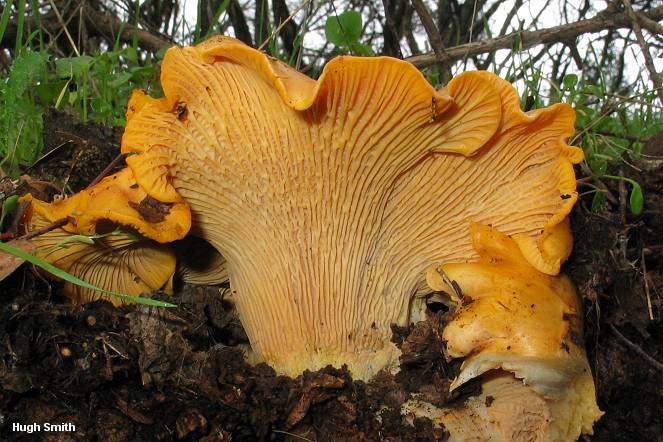The recent fires in Santa Barbara, followed by this winter’s rain, resulted in a field day for mushroom collectors, and 2010 produced a bumper crop of two of the most highly prized wild mushrooms, morels and chanterelles. Morels proliferate in habitats that have been scorched by a forest fire, and chanterelles (along with most mushrooms) tend to fruit after the first heavy rain of the year, especially when the rain is followed by a warm spell.
In classical times, the origins of mushrooms were a mystery which challenged many; “Plutarch and others thought them the result of lightning, warmth and water in the soil” (Wikipedia). Warmth and water, while not an “origin,” certainly promote the growth of mushrooms, but what about lightning? As it turns out, Plutarch may have been closer to the mark than you might think. In an April 9, 2010 National Geographical News article titled “Lightning Makes Mushrooms Multiply,” Julian Ryall writes:
Lightning makes mushrooms more plentiful, according to ongoing research that offers a solid scientific basis for Japanese farming lore. For generations, Japanese farmers have welcomed storms over their fields based on the belief that lightning strikes provoke plentiful harvests of mushrooms, which are staples of Japanese cuisine. Currently, mushroom demand is so high that dealers are increasingly turning to foreign suppliers. Japan imports about 50,000 tons of mushrooms a year, mainly from China and South Korea.
As part of a four-year study, scientists in northern Japan have been bombarding a variety of mushrooms in lab-based garden plots with artificially induced lightning to see if electricity actually makes the fungi multiply. The latest results show that lightning-strength jolts of electricity can more than double the yield of certain mushroom species compared with conventional cultivation methods. “We have tried these experiments with ten types of mushroom so far and have found that it is effective in eight species,” said Koichi Takaki, an associate professor in engineering at Iwate University. “We saw the best effects in shiitake and nameko mushrooms, while we also tested reishi mushrooms, which are not edible but are used in certain types of traditional Chinese medicine,” he said.
Takaki’s team has been applying high-voltage pulses to logs seeded with mushroom spores to try to stimulate mushroom growth. Naturally occurring lightning can carry up to a billion volts of electricity, which get carried through the ground during a lightning strike. A direct hit with that much energy would fry the mushrooms. Instead, it’s more likely mushrooms near the strike zone grow after being exposed to a weakened charge traveling through the soil, so the researchers have been using gentler bursts of electricity. Repeated tests have shown that the fungi react best when they’re exposed to between 50,000 and 100,000 volts for one ten-millionth of a second. Given the right amount of electricity, the shiitake crop yielded double the amount harvested from logs not exposed to an energy burst. The amped-up nameko logs produced 80 percent more mushrooms. “The reaction of the mushrooms to this sudden burst of energy is initially to decrease the proteins and enzymes secreted by their hyphae, followed by a sudden increase,” Takaki said. Hyphae are elongated cells that act like roots for mushrooms, anchoring the spores in the ground and taking in nutrients. The hyphae also give rise to new fruiting bodies, the fleshy, capped structures that produce spores and are harvested as crops. The reason for the hyphae’s reaction to lightning is still being studied. But it’s possible the mushrooms are giving themselves a reproductive boost in response to danger, said Yuichi Sakamoto, chief researcher at the Iwate Biotechnology Research Center, who has been working with Takaki’s team. “For mushrooms, a lightning strike would be a very serious threat that could easily kill them off,” Sakamoto said. “I think they have the need to regenerate before they die, and when they sense lightning, they automatically accelerate their development” and produce more fruiting bodies, he said.
Based on the successes so far, Takaki and Sakamoto think machines for delivering lightning-like bursts could become a boon to commercial farmers—although first the team needs to make the technology more user-friendly. “Right now, the equipment that we use to grow these mushrooms is very specialized and complicated, so I want to improve the design to make it easy to operate,” Takaki said. “We want to collaborate with commercial mushroom farmers and eventually commercialize this technology.” Takaki’s team has also started similar experiments on daikon radishes, with early tests indicating that the species tends to bud earlier when exposed to artificial lightning. Lightning tests are being conducted at other institutions on rapeseed plants, beans, and some varieties of lily, Takaki added.





